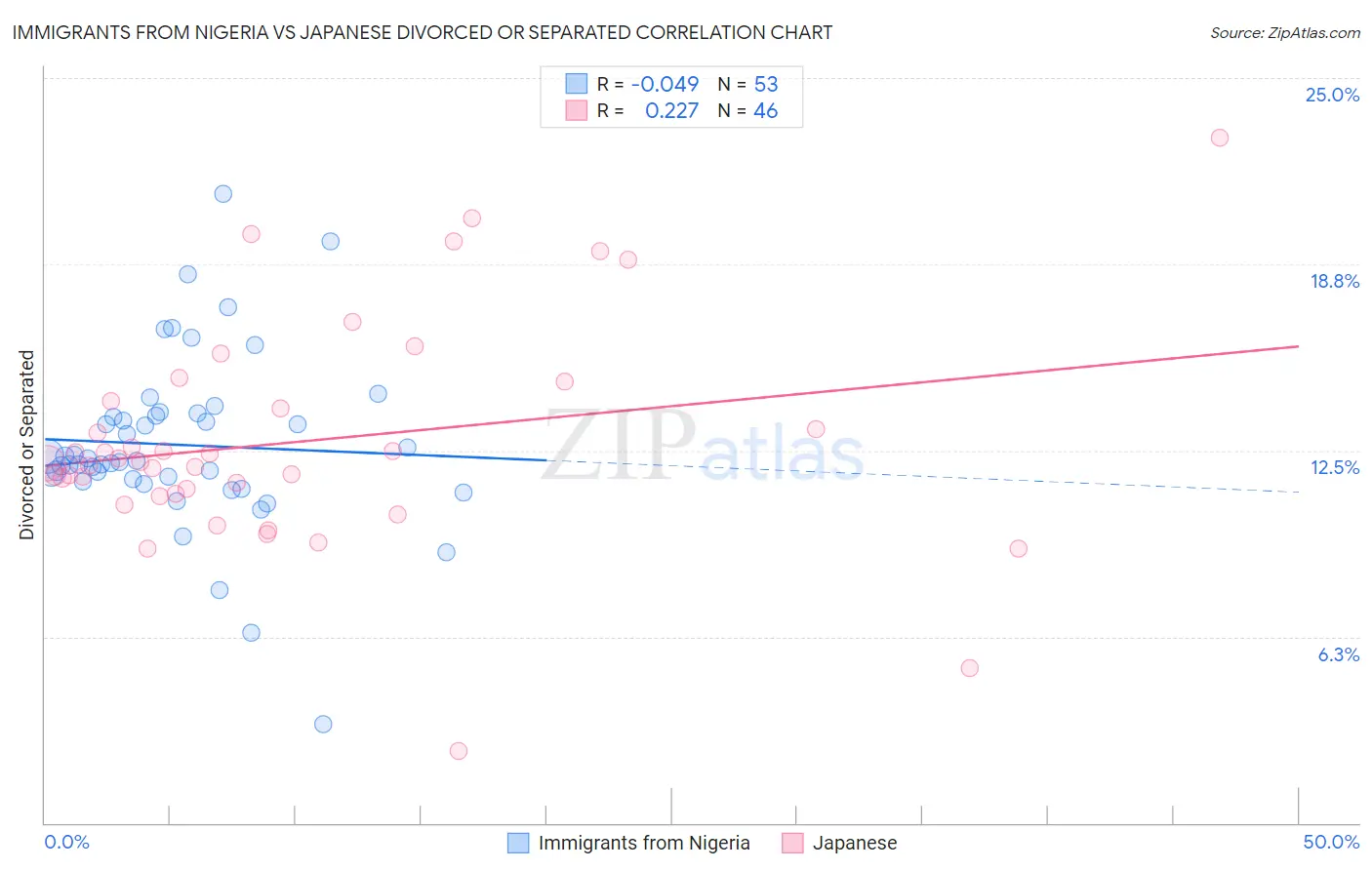Immigrants from Nigeria vs Japanese Divorced or Separated
COMPARE
Immigrants from Nigeria
Japanese
Divorced or Separated
Divorced or Separated Comparison
Immigrants from Nigeria
Japanese
12.1%
DIVORCED OR SEPARATED
40.5/ 100
METRIC RATING
185th/ 347
METRIC RANK
12.0%
DIVORCED OR SEPARATED
70.9/ 100
METRIC RATING
155th/ 347
METRIC RANK
Immigrants from Nigeria vs Japanese Divorced or Separated Correlation Chart
The statistical analysis conducted on geographies consisting of 283,324,387 people shows no correlation between the proportion of Immigrants from Nigeria and percentage of population currently divorced or separated in the United States with a correlation coefficient (R) of -0.049 and weighted average of 12.1%. Similarly, the statistical analysis conducted on geographies consisting of 249,125,963 people shows a weak positive correlation between the proportion of Japanese and percentage of population currently divorced or separated in the United States with a correlation coefficient (R) of 0.227 and weighted average of 12.0%, a difference of 1.1%.

Divorced or Separated Correlation Summary
| Measurement | Immigrants from Nigeria | Japanese |
| Minimum | 3.3% | 2.4% |
| Maximum | 21.1% | 23.0% |
| Range | 17.8% | 20.6% |
| Mean | 12.7% | 12.8% |
| Median | 12.2% | 12.1% |
| Interquartile 25% (IQ1) | 11.5% | 11.1% |
| Interquartile 75% (IQ3) | 13.7% | 14.1% |
| Interquartile Range (IQR) | 2.2% | 3.1% |
| Standard Deviation (Sample) | 2.9% | 3.8% |
| Standard Deviation (Population) | 2.9% | 3.7% |
Similar Demographics by Divorced or Separated
Demographics Similar to Immigrants from Nigeria by Divorced or Separated
In terms of divorced or separated, the demographic groups most similar to Immigrants from Nigeria are Immigrants from North America (12.1%, a difference of 0.020%), Immigrants from Chile (12.1%, a difference of 0.050%), Immigrants from Ethiopia (12.1%, a difference of 0.090%), Immigrants from Central America (12.1%, a difference of 0.090%), and Belizean (12.1%, a difference of 0.10%).
| Demographics | Rating | Rank | Divorced or Separated |
| Ghanaians | 45.9 /100 | #178 | Average 12.1% |
| Immigrants | Western Europe | 45.6 /100 | #179 | Average 12.1% |
| Barbadians | 45.0 /100 | #180 | Average 12.1% |
| Immigrants | Canada | 44.0 /100 | #181 | Average 12.1% |
| Immigrants | Ethiopia | 43.1 /100 | #182 | Average 12.1% |
| Immigrants | Central America | 42.9 /100 | #183 | Average 12.1% |
| Immigrants | North America | 41.1 /100 | #184 | Average 12.1% |
| Immigrants | Nigeria | 40.5 /100 | #185 | Average 12.1% |
| Immigrants | Chile | 39.0 /100 | #186 | Fair 12.1% |
| Belizeans | 37.7 /100 | #187 | Fair 12.1% |
| Immigrants | Belize | 37.6 /100 | #188 | Fair 12.1% |
| Sierra Leoneans | 35.5 /100 | #189 | Fair 12.1% |
| Moroccans | 34.8 /100 | #190 | Fair 12.1% |
| Swedes | 34.4 /100 | #191 | Fair 12.1% |
| Norwegians | 33.2 /100 | #192 | Fair 12.1% |
Demographics Similar to Japanese by Divorced or Separated
In terms of divorced or separated, the demographic groups most similar to Japanese are Chilean (12.0%, a difference of 0.020%), Hungarian (12.0%, a difference of 0.020%), Austrian (12.0%, a difference of 0.060%), Immigrants from Brazil (12.0%, a difference of 0.090%), and Immigrants from Hungary (11.9%, a difference of 0.12%).
| Demographics | Rating | Rank | Divorced or Separated |
| Italians | 77.8 /100 | #148 | Good 11.9% |
| Immigrants | Oceania | 77.7 /100 | #149 | Good 11.9% |
| Immigrants | Portugal | 77.3 /100 | #150 | Good 11.9% |
| Czechs | 76.4 /100 | #151 | Good 11.9% |
| Immigrants | Hungary | 73.7 /100 | #152 | Good 11.9% |
| Austrians | 72.2 /100 | #153 | Good 12.0% |
| Chileans | 71.3 /100 | #154 | Good 12.0% |
| Japanese | 70.9 /100 | #155 | Good 12.0% |
| Hungarians | 70.3 /100 | #156 | Good 12.0% |
| Immigrants | Brazil | 68.8 /100 | #157 | Good 12.0% |
| Icelanders | 66.0 /100 | #158 | Good 12.0% |
| Immigrants | Barbados | 66.0 /100 | #159 | Good 12.0% |
| Immigrants | Scotland | 65.8 /100 | #160 | Good 12.0% |
| Marshallese | 64.6 /100 | #161 | Good 12.0% |
| Samoans | 64.3 /100 | #162 | Good 12.0% |